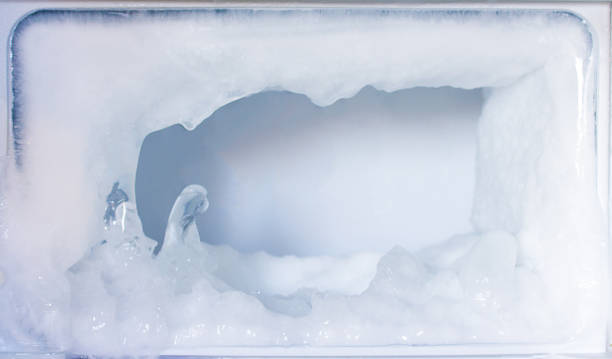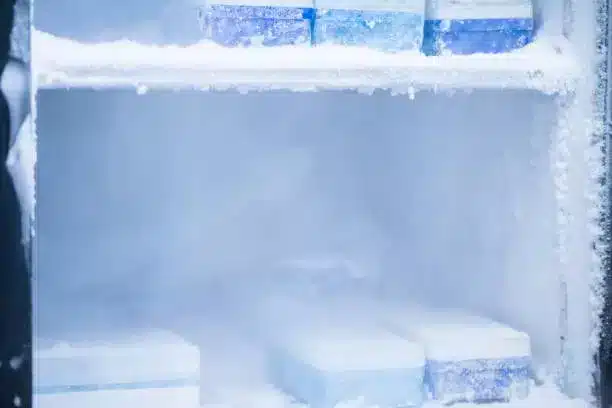Your GE freezer is a great appliance that keeps your food frozen and safe for a long time. But sometimes, you may notice frost or ice buildup on the interior walls or shelves of your freezer. This can reduce your storage space, affect your food quality, and increase your energy bills.
Why does your GE freezer frost up and how can you deal with it? In this post, we’ll help you answer these questions and guide you through some prevention and solutions tips for GE freezer frosting up.
The main cause of GE freezer frosting up is moisture entering the freezer and freezing on the evaporator coils or other surfaces. This can happen due to a damaged or worn-out door seal, an open freezer door, hot food placed in the freezer, or a faulty defrost system.
To prevent and fix GE freezer frosting up, you need to check and replace the door seal, close the door properly, cool the food before freezing, and defrost the freezer manually or automatically.
What causes GE freezer frosting up?
GE freezer frosting up is caused by moisture entering the freezer and freezing on the evaporator coils or other surfaces. The moisture can come from different sources, such as:
- A damaged or worn-out door seal: The door seal or gasket is a rubber or silicone strip that seals the gap between the door and the freezer body. It prevents warm air from entering and cold air from escaping the freezer. If the door seal is cracked, torn, or loose, it can allow moisture to enter the freezer and cause frost buildup.
- An open freezer door: The freezer door should be closed tightly and completely after every use. If the door is left open or slightly ajar for a long time, it can let warm air and humidity enter the freezer and cause frost buildup. The door may also not close properly if something is blocking it or if the freezer is not level with the ground.
Hot food placed in the freezer: The food that you put in the freezer should be cooled down first before freezing. If you put hot or warm food in the freezer, it can introduce humidity and heat to the unit, which can result in frost buildup. It can also make your freezer work harder to cool down the food and consume more energy.
- A faulty defrost system: Most modern freezers have an automatic defrost system that periodically melts the frost on the evaporator coils and drains it away. The defrost system consists of a timer, a heater, and a thermostat that work together to regulate the defrost cycle. If any of these components are defective or malfunctioning, they can prevent the defrost system from working properly and cause frost buildup.

How to prevent GE freezer frosting up?
GE freezer frosting up can be prevented by following some simple tips, such as:
- Check and replace the door seal: Inspect the door seal regularly for any signs of damage or wear and tear. You can also test the seal by closing the door on a dollar bill and pulling it out. If it slides out easily, it means the seal is loose and needs to be replaced. You can buy a new door seal online or at a local hardware store and install it yourself or hire a professional technician.
- Close the door properly: Make sure you close the door tightly and completely after every use. Avoid opening and closing the door too frequently or too forcefully. Also, make sure nothing is blocking the door from closing fully, such as food items or containers. You can also adjust the leveling feet or screws of your freezer to make sure it is level with the ground.
- Cool the food before freezing: Let the food cool down on the counter until it is no longer hot, and then refrigerate it to chill further before storing it in the freezer. You can also use shallow containers or ziplock bags to freeze your food faster and more evenly. Avoid overloading or underloading your freezer as well.
- Defrost your freezer regularly: If your freezer does not have an automatic defrost system or if it is not working properly, you may need to defrost your freezer manually every few months or whenever you notice frost buildup more than 1/4 inch thick. To do this, you need to unplug your freezer, empty it of all food items, place towels or pans to catch the melting water, and wait for several hours until all the frost melts. You can also use a hairdryer or a fan to speed up the process, but do not use any sharp tools to scrape off the ice as they may damage your freezer. After defrosting, wipe off any remaining water, plug in your freezer, and refill it with your food items.

FAQs
Q: How do I know if my defrost system is faulty?
A: Some signs that your defrost system is faulty include:
- Frost buildup on the back wall of your freezer
- Warm or spoiled food in your freezer
- Ice or water on the floor under your freezer
- A clicking or buzzing sound coming from your freezer
If you suspect that your defrost system is faulty, you should contact a professional technician or an authorized service provider for help. You can also call GE customer service or visit the GE website for more information and assistance.
Q: How can I improve the efficiency and performance of my freezer?
A: You can improve the efficiency and performance of your freezer by following these tips:
- Set the temperature of your freezer to the manufacturer’s recommended setting (usually 0°F) and use a freezer thermometer to monitor it. If it gets too warm or cold, you may need to troubleshoot your freezer or call a repair professional.
- Clean the condenser coils at least once a year with a vacuum or brush to remove dust and dirt. The condenser coils are located at the back or bottom of your freezer and help to dissipate heat and cool down your freezer. Dirty coils can reduce the airflow and cooling capacity of your freezer and cause it to consume more energy.
- Replace the water filter (if applicable) every six months or as recommended by the manufacturer. The water filter is located inside or behind your freezer and helps to filter the water supply to your ice maker or dispenser. A clogged or dirty filter can reduce the water flow and quality and affect the performance of your ice maker or dispenser.
Q: What should I do if I can’t prevent or fix my GE freezer frosting up?
A: If you can’t prevent or fix your GE freezer frosting up by yourself, you should contact a professional technician or an authorized service provider for help. You can also call GE customer service or visit the GE website for more information and assistance.
Conclusion
GE freezer frosting up is a common issue that can be caused by moisture entering the freezer and freezing on the evaporator coils or other surfaces. The moisture can come from a damaged or worn-out door seal, an open freezer door, hot food placed in the freezer, or a faulty defrost system. To prevent and fix GE freezer frosting up, you need to check and replace the door seal, close the door properly, cool the food before freezing, and defrost the freezer manually or automatically.



